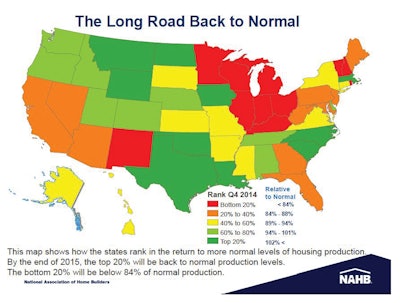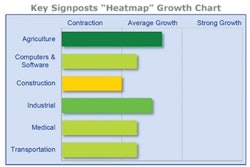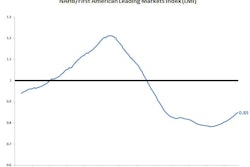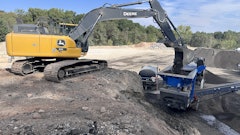
With home prices and household formations rising and household balance sheets healing, the ongoing housing recovery is expected to gain momentum next year even as several challenges remain, according to economists who participated in yesterday's National Association of Home Builders (NAHB) Fall 2013 Construction Forecast Webinar.
"The cards are in play for a decent and fairly strong recovery in 2014 and particularly in 2015," said NAHB Chief Economist David Crowe. "From the standpoint of GDP growth, housing has been a plus, growing at two, three and four times the rate of the rest of the economy in recent quarters."
Helping to spur the housing rebound was a double-digit increase in home prices over the past year, driven in part by tight inventories of new and existing homes for sale and gradual gains in employment.
"We expect to see price increases moderate in the next few years as we see additional inventory on the market and investors back away as the bargains disappear," said Crowe.
Another bright spot is rising household formations that were delayed during the downturn as college graduates and young professionals were forced to move back in with their parents or double up as roommates. At the height of the housing boom, the U.S. was producing 1.4 million additional households every year. That figure plunged to 500,000 during the depth of the recession and today is now back up to 700,000.
Meanwhile, households across the nation have been increasing their savings and shedding debt. "They've corrected a lot of excesses and feel more comfortable about moving forward," Crowe said, noting that the University of Michigan Consumer Sentiment Index shows that the percentage of consumers who believe that now is a good time to buy a house is back up to levels last seen near the housing boom.
However, Crowe cited several headwinds that are impeding the recovery.
"Credit conditions are much tighter now, builders are increasingly facing labor shortages, lot supplies are tight, building material prices are rising, and inaccurate appraisals are hurting home sales" he said.
"You can't charge more than you can get an appraisal for," Crowe added. "Even though we are seeing price increases in labor, land and materials, 36 percent of builder recently said they had lost at least one sale over appraisals coming in below the cost of production."
A solid outlook
NAHB is forecasting 924,000 total housing starts in 2013, up 18 percent from 783,000 units last year.
Single-family production is expected to rise 17 percent this year to 629,000 units, jump an additional 31 percent next year to 826,000 and surpass the 1 million mark in 2015.
NAHB is projecting that multifamily starts will increase 20 percent in 2013 to 296,000 units and rise an additional 10 percent to 326,000 units next year, which Crowe characterized as a normal level of multifamily production.
Meanwhile, residential remodeling has returned to previously normal levels of the early 2000s and remodeling activity is expected to register a modest gain this year over 2012.
"Our Remodeling Market Index has been above 50 for three of the last four quarters, indicating that remodelers feel things are going better," said Crowe. "Remodeling did not fall as much, so it does not have as much ground to make up."
Dodging a bullet
Regarding the uncertainties emanating out of Washington over the government shutdown and the impending Oct. 17 deadline when the government will run out of cash to pay its bills, Mark Zandi, chief economist at Moody's Analytics, expressed optimism that Congress will move quickly to resolve these critical issues.
"I truly anticipate that lawmakers will get it together, but that is definitely a challenge to my economic outlook," said Zandi. "If policymakers can't get it together by Oct. 17, we're toast, and I think we are going into recession."
Assuming the government meets these challenges, Zandi cited three reasons for optimism moving forward. First, the fiscal drag that is weighing heavily on the economy in the form of tax increases and government spending cuts that are now being implemented will continue to fade in the coming years. This fiscal drag will shave 1.5 percent off of GDP growth this year, about 0.7 percent next year and gradually fall to zero by 2016, he said.
Second, Zandi noted that the "private economy has done a marvelous job of reducing leverage and getting their balance sheets in order. American companies are in very good shape and they will do well going forward, with continued strong export growth. That will be a strong source of economic growth for a long time to come."
Finally, Zandi said that demographics make a compelling argument for a strengthening housing market.
"In the current housing market, supply is running around 950,000 annual units," he said. "In a normal economy, we should be producing 1.7 million units. That's a big difference. We've already made a lot of progress in working off excess inventory. We won't get housing construction up to 1.7 million quickly. The big problem in the next five years won't be too much housing but too little housing."
All markets are local
Looking beneath the national numbers, Robert Denk, NAHB's assistant vice president for forecasting and analysis, noted a range of conditions across the country and differences among the states in the amount of distress suffered during the recession and the headway that is being made in recovery.
Housing nationwide bottomed out at an average of 27 percent of normal production in early 2009.
The hardest hit states where production soared to unsustainable levels during the boom years - California, Nevada, Arizona and Florida - bottomed out at 10 to 20 percent of normal when the housing bubble burst. In sharp contrast, better states that did not experience a huge production run up during the boom declined to 50 percent of normal production.
"We've now gotten past the point where we are digging out of holes and repairing the carnage of the housing markets," said Denk. "It's no longer about the boom and the bust. Now it's about the underlying [state and regional] economies and how that is supporting the housing recovery."
For example, while Texas and Florida have roughly the same number of mortgages, Florida had nearly five times as many foreclosures during the height of the downturn and today has less than double.
Now that housing has entered a new stage in the healing process, local economic conditions are dictating the pace of recovery. "That's why the bubble states are no longer in the bottom tier and have moved ahead of the industrial Midwest," he said.
The gradual and steady housing recovery now underway across the land will bring nationwide housing starts to 71 percent of normal by the fourth quarter of next year and 93 percent of normal by the end of 2015, Denk said.
Leading the way will be oil and gas producing states Texas, Oklahoma, North Dakota, Louisiana, Wyoming and Montana; and Iowa, supported by agricultural commodities.
In another way of looking at the long road back to normal, by the end of 2015 the top 20 percent of states will be back to normal production levels, compared to the bottom 20 percent, which will still be below 84 percent.


















